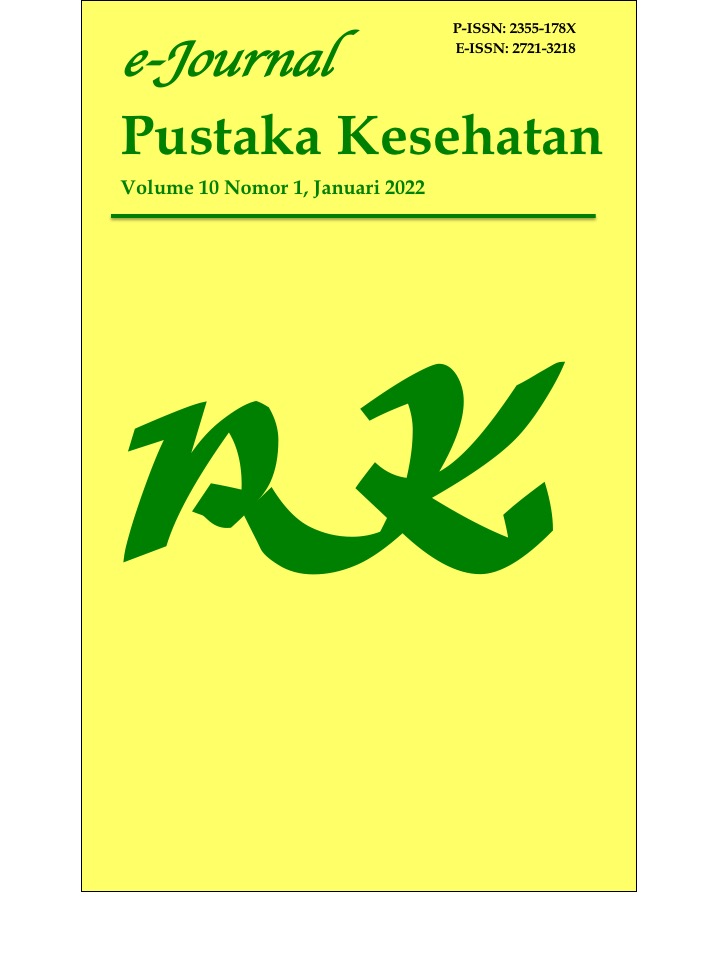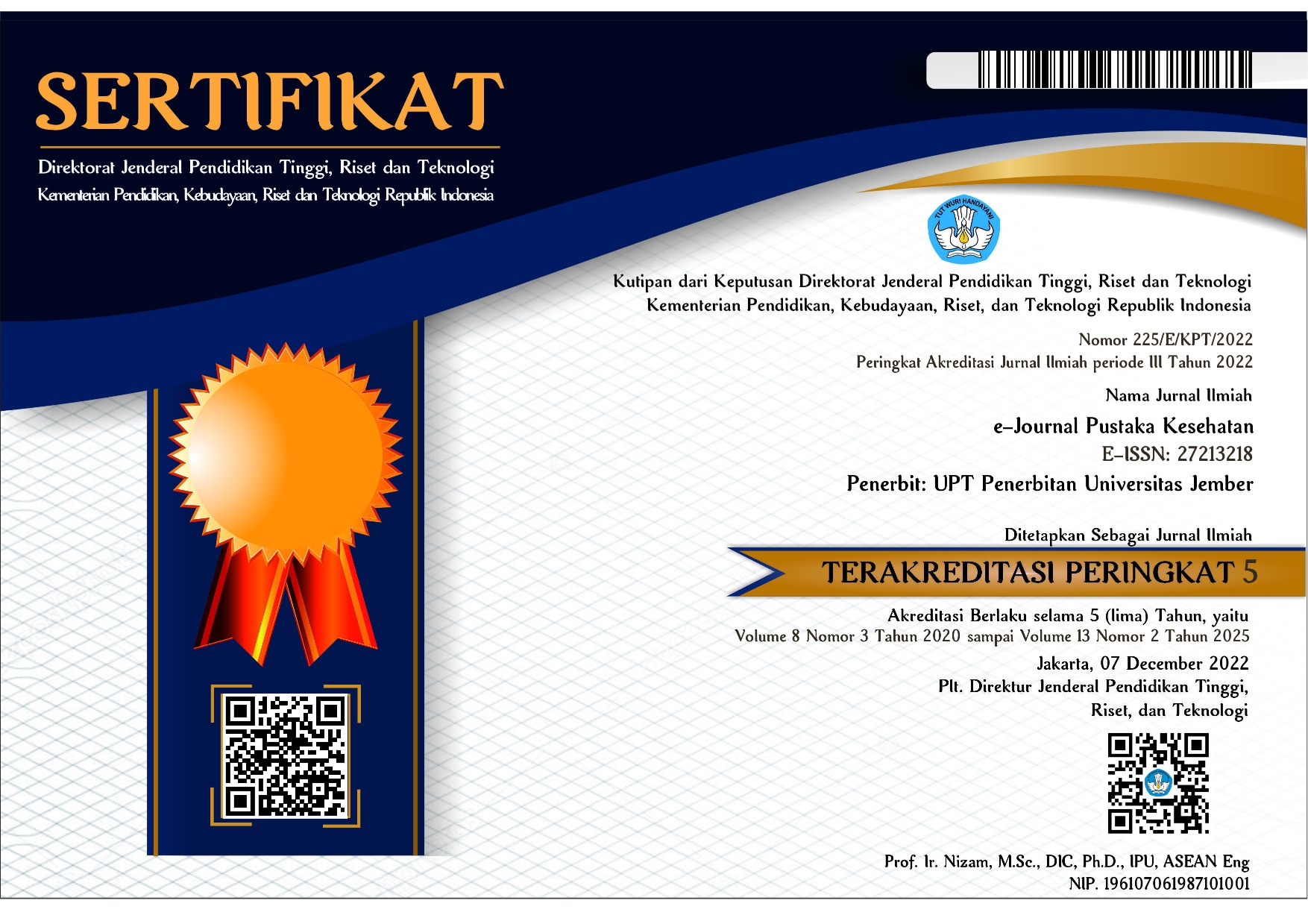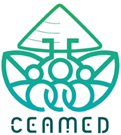Hubungan efikasi diri dengan mekanisme koping siswa dalam menghadapi tugas di SMA Negeri 1 Jember
DOI:
https://doi.org/10.19184/pk.v10i1.11085Keywords:
self-efficacy, coping mechanism, student assignmentAbstract
Adolescence period is a transition period of human development between childhood and adulthood starting at the age of 12 or 13 years and ending at the last teenage years. Teenagers are in a high school period. In this period, teenagers undergo stress since they faced various jobs or tasks simultaneously, such as school assignments, and the burden of learning which was felt quite hard. Moreover, High School is currently following the 2013 curriculum by applying the Semester Credit Unit where students are required to find out in advance to do the assignments. Teenagers needed the confidence to resolve the demands of school duties. This study identified the relationship between self-efficacy and student coping mechanisms in dealing with assignments. The research design applied correlation analysis with a cross-sectional approach. The data collection technique used was stratified random sampling with 243 respondents. Data collection was carried out using the self-efficacy questionnaire and Children's Coping Questionary. The results of data analysis performed the Pearson correlation that revealed a score of p-value 0.00; r: 0.332; meaning that there was a relationship between self-efficacy and coping mechanisms of students in facing assignments in SMA 1 Jember. Therefore, it was needed teachers and parents support in providing motivation to students so that their self-efficacy of students was able to increase and produce an adaptive coping mechanism.
Downloads
References
[1]. Jahja, Yudik. Psikologi Perkembangan. Jakarta: Kencana;2011
[2] Feist, J. & Gregory J. Feist. Theories of Personality (Edisi Keenam). Yogyakarta: Pustaka Pelajar; 2009
[3] BKKBN. Profil Hasil Pendataan Keluarga Tahun 2011. Jakarta: Badan Kependudukan dan Keluarga Berencana Nasional Direktorat Pelaporan dan Statistik; 2011 [update 2018 jan 12;cited 2018 Feb 12]. Available from: https://www.bkkbn.go.id/
[4] BAPPENAS, BPS dan UNFPA. Proyeksi Penduduk Indonesia 2010-2035. Jakarta: BPS; 2013 [update 2018 Nov 21;cited 2018 Feb 12]. Available from: https://www.bps.go.id/publication/2013/10/07/053d25bed2e4d62aab3346ec/proyeksi-penduduk-indonesia-2010-2035.html
[5] Desmita. Psikologi Perkembangan Peserta Didik. Bandung: PT Remaja Rosdakarya; 2014.
[6] Zimmerman,B.J. A social cognitive view of self-regulated academic learning. Journal of Educational Psychology [Internet]. 2018 Jan [cited 2019 Feb 20]:4(2),22-63. Available from: https://www.researc hga te.net/publication/232534584_A_Social_Cognitive_View_of_SelfRegulated_Academic_Learning
[7] Kemendikbud. Panduan Penilaian oleh Pendidik dan Satuan Pendidikan untuk Sekolah Menengah Atas. Jakarta: Direktorat Jenderal Pendidikan Dasar dan Menengah; 2017 [cited 2018 Feb 15]. Available from: https://www.kemdikbud.go.id/main/
[8] Fadlillah, Muhammad. Pelaksanaan Pembelajaran Berbasis Kurikulum 2013 di TK IT Qurrota a’yun Babadan Ponorogo. Early Childhood [Internet]. 2018 Apr [cited 2019 Feb 12]:2(1). Available from: https://journal.umtas.ac.id/index.php/EARLYCHILDHOOD/article/view/200
[9] Pervin, L. A. & Cervone. Kepribadian: Teori dan penelitian (jilid 2). Jakarta: Salemba Humanika, 2012.
[10] Nofina,D. Tingkat Efikasi Diri Siswa Sekolah Menengah Pertama Dan mImplikasi Terhadap Penyusunan Topik- Topik Bimbingan Peningkatan Efikasi Diri. Universitas Sanata Dharma: Yogyakarta [Internet].2017 Apr [cited 2018 Feb 12]. Availablefrom:https://repository.usd.ac.id/27707/2/141114042_full.pdf
[11] Ujang Candra. Faktor – faktor penyebab prokrastinasi akademik pada siswa kelas IX SMA Negeri Kabupaten Temanggung. Fakultas Ilmu Pendidikan: Universitas Negeri Semarang [Internet].2014 Apr [cited 2018 Feb 12];3(3).Available from: https://journal.unnes.ac.id/sju/index.php/jbk/article/view/3787
[12] Whaley dan Wong,Buku Ajar Keperawatan Pediatrik, edisi 2. Jakarta: EGC, 2010.
[13] Mustika, R.A & Sulisworo K. Studii deskriptif student engagement pada siswa kelas XI di SMA Pasundan 1 Bandung. Jurnal Ilmiah Mahasiswa Fakultas Psikologi Universitas Islam: Bandung [Internet].2017 Mar [cited 2019 Feb 12]:75(3). Available from: http://karyailmiah.unisba.ac.id/index.php/psikologi/article/view/1204
[14] Adelina Haryono. Prevalensi Gangguan Tidur pada Remaja Usia 12-15 Tahun di Sekolah Lanjutan Tingkat Pertama. Sari Pediatri :Universitas Indonesia; 2009.
[15] Berman, A & Snyder, S, J. Fundamentals of nursing : concepts, process and practice (9th.ed). Boston : Pearson; 2009.
[16] Eccles, J & Wang, M.T. School context, achievement motivation, and academic engagement:A longitudinal study of school engagement using a multidimensional perspective. Learning and Instruction [Internet]. 2013 Jan [cited 2019 Apr 14]:28(3): Available from: https://www.semanticscholar.org/paper/School-context%2C-achievement.html
[17] Bandura, A.Self Efficacy, the exercise ofcontrol. New York: Freeman and Company; 1997.
[18] Corey, G.Teori dan Praktek Konseling dan Psikoterapi. Bandung: Refika Aditama; 2007.
[19] Melisa.Tingkat Efikasi Diri Dalam Belajar Siswa SMK.Universitas Sanata Dharma: Yogyakarta; 2018.
[20] Keliat, B.A. Peran Serta Keluarga Dalam Perawatan Klien Gangguan Jiwa. Jakarta : EGC; 2006.
[21] Suyono & Hariyanto. Belajar dan Pembelajaran. PT. Remaja Rosdakarya. Bandung; 2016.
[22] Widodo, B. Motivasi Berprestasi dan Self Efficacy.Konselor dengan Interaksi Konseling. Jurnal Psiko-Edukasi randomized clinical trial. J Clin Periodontol [Internet]. 2008 Aug [cited 2018 Apr 15]:35(8): 696-704. Available from:https://journal.unnes.ac.id/sju/index.php/jbk/article/view/19104
Downloads
Published
Issue
Section
License
e-Journal Pustaka Kesehatan has CC-BY-SA or an equivalent license as the optimal license for the publication, distribution, use, and reuse of scholarly work. Authors who publish with this journal retain copyright and grant the journal right of first publication with the work simultaneously licensed under a Creative Commons Attribution-ShareAlike 4.0 International License that allows others to share the work with an acknowledgment of the work's authorship and initial publication in this journal.







